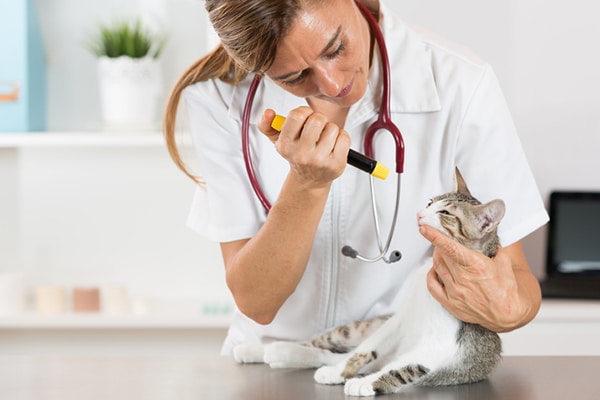Cat Eye Discharge — What’s Normal and What’s Not
The post Cat Eye Discharge — What’s Normal and What’s Not by Jackie Brown appeared first on Catster. Copying over entire articles infringes on copyright laws. You may not be aware of it, but all of these articles were assigned, contracted and paid for, so they aren't considered public domain. However, we appreciate that you like the article and would love it if you continued sharing just the first paragraph of an article, then linking out to the rest of the piece on Catster.com.
Do your cat’s eyes ever get watery, goopy or downright crusty? Cat eye discharge can be a little gross, but beyond that, cat eye discharge can sometimes indicate an eye problem that needs veterinary attention. If you’ve ever wondered if cat eye boogers, watery cat eyes or other cat eye discharge are normal or what could be causing them, you’re not alone.
First, what is cat eye discharge?

Cat eye discharge should be brought to your vet’s attention — sometimes. Photography by fotoedu/Thinkstock.com.
“Tears are produced constantly throughout the day and normally drain at the corner of the eye without spilling over,” says Beth Kimmitt, D.V.M., resident of ophthalmology at Purdue University’s College of Veterinary Medicine in West Lafayette, Indiana. “If something causes irritation to the eye, more tears are produced. Irritation to the eye or blockage of the normal drainage pathway may lead to tears that spill over onto the face.”
Read on to get the scoop on what’s normal and what’s not when it comes to cat eye discharge:
1. A small amount of cat eye discharge is probably nothing to worry about.
“While technically a normal eye should not have any ocular discharge, a small amount of clear discharge, which may dry and appear slightly brown and crusty, may be OK,” Dr. Kimmitt says. Seeing morning eye boogers on your cat? This type of cat eye discharge probably isn’t a cause for alarm.
2. Some breeds are more prone to things like cat eye boogers.
Due to the shape of the face, Persians, Himalayans and other cats with short noses and large, round eyes (brachycephalic cat breeds) are more susceptible to cat eye discharge. This might be normal, but if your cat’s eye discharge is excessive, ask your vet.
3. Some cat eye discharge warrants a trip to the vet.
Yellow or green eye discharge is not normal — if your cat has colored discharge, make a vet appointment as soon as possible. “If there is enough discharge that you have to wipe your pet’s eye(s) more than one to two times daily, or if your cat is squinting or frequently rubbing at his eye(s), or if the eye(s) look red, he should be seen by a veterinarian,” Dr. Kimmitt says. When it comes to your cat eye discharge and other eye issues, don’t delay making that vet appointment — your cat’s eyes and eyesight might depend on it.
4. Many things can cause abnormal cat eye discharge.
Cat eye discharge is a sign of many different eye diseases and disorders, including corneal ulcers, conjunctivitis and entropion (an eyelid that rolls inward, allowing the hairs on the skin to irritate the eye). Your veterinarian will examine your cat and possibly perform certain tests to find out what exactly is causing your cat’s eye discharge.
5. It’s important to keep your cat’s eye area clean.
Use a soft, wet cloth to gently wipe away any discharge. “There are also a variety of veterinary products available to help clean around the eyes,” Dr. Kimmitt says. “Just be sure to find one that is labeled as safe to be used around the eyes, and avoid any product that contains alcohol.”
Tell us: Have you ever dealt with cat eye boogers, watery cat eyes or other cat eye discharge? What are your tips and tricks for handling cat eye discharge? Let us know!
Struggling with eye discharge yourself? Could one of these eye infections be at play? >>
This piece was originally published in 2017.
Thumbnail: Photography by Warapatr_s/Thinkstock.com.
About the author
Pet expert Jackie Brown has spent 20 years following her passion for animals as a writer and editor in the pet publishing industry. She is contributing writer for National Geographic’s Complete Guide to Pet Health, Behavior, and Happiness: The Veterinarian’s Approach to At-Home Animal Care (April 2019) and author of the book It’s Raining Cats and Dogs: Making Sense of Animal Phrases (Lumina Press, 2006). Jackie is a regular contributor to pet and veterinary industry media and is the former editor of numerous pet magazines, including Dog World, Natural Dog, Puppies 101, Kittens 101 and the Popular Cats Series. Prior to starting her career in publishing, Jackie spent eight years working in veterinary hospitals where she assisted veterinarians as they treated dogs, cats, rabbits, pocket pets, reptiles, birds and one memorable lion cub. She lives in Southern California with her husband, two sons and miniature poodle Jäger. Reach her at jackiebrownwriter.wordpress.com.
Read more on your cat’s eyes:
The post Cat Eye Discharge — What’s Normal and What’s Not by Jackie Brown appeared first on Catster. Copying over entire articles infringes on copyright laws. You may not be aware of it, but all of these articles were assigned, contracted and paid for, so they aren't considered public domain. However, we appreciate that you like the article and would love it if you continued sharing just the first paragraph of an article, then linking out to the rest of the piece on Catster.com.




Post a Comment